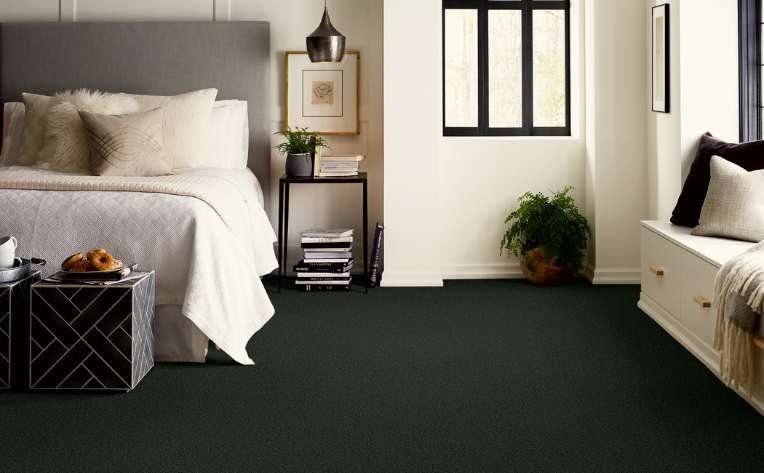Dark Carpet Is Depressing: Understanding the Psychological Impact and Design Solutions
Dark Carpet Is Depressing : Carpet color plays a crucial role in shaping the mood of a room. People often perceive dark-colored carpets as depressing, and for good reason. In this article, we will explore why dark carpet is associated with negative feelings, examine the psychological effects of dark colors, discuss how flooring influences interior design, and provide solutions for creating a home that feels uplifting, positive, and comfortable.
Read also : Why Buying Antique Furniture Online Can Be a Great Investment
The Psychological Effects of Dark Colors
Colors evoke strong emotions and influence our mental state in subtle yet profound ways. Dark colors, such as deep blues, greys, and blacks, tend to generate feelings of heaviness, sadness, and gloom. People often associate dark shades with negative emotions, such as melancholy or confinement, because these colors absorb light and create a sense of restriction.
Research in color psychology shows that dark colors tend to make a space feel smaller, often causing people to feel emotionally restrained. The association with darkness, stormy weather, and mourning adds to the sense of gloom. These feelings can dampen the overall mood of a room and make it less inviting.
Dark colors in interior design can create a somber atmosphere, which may not be conducive to relaxation or positive energy. While dark shades may work in smaller accent pieces or dramatic spaces, they often give a room a dim, cold, and isolating feel when used extensively on flooring. When paired with other muted tones, dark carpets can result in an oppressive ambiance.
How Dark Carpets Impact the Room’s Ambiance
The choice of carpet color impacts not just the visual aesthetic of a room but its overall mood. Flooring serves as a foundation for the entire space, influencing every other design decision that follows. Dark carpet often sets a heavy tone, overshadowing other design elements.
In rooms with dark carpets, light gets absorbed rather than reflected, making the space feel smaller and less inviting. With minimal natural light, dark carpets exacerbate the situation, creating a feeling of confinement. This can make people feel trapped in the space, intensifying their discomfort or depressive feelings.
In contrast, lighter flooring colors reflect light, which helps brighten up a space and makes it feel open and airy. The warmth and energy that lighter tones bring contribute positively to the room’s atmosphere. In many cases, dark carpets become a visual barrier, limiting the room’s design potential and diminishing its overall ambiance.
Cultural and Emotional Associations with Dark Carpet
The emotional responses to dark carpets are shaped not only by color psychology but also by cultural influences. Dark colors often symbolize mourning, loss, and grief in many cultures. For instance, black has long been a color of mourning in Western societies, and using it in flooring can unintentionally evoke feelings of sadness or sorrow.
Dark carpets often appear in formal or professional settings, which reinforces their association with seriousness or austerity. When incorporated into home spaces, these carpets can bring an air of solemnity that feels out of place in casual, relaxing environments. This contrast can undermine the cheerful, vibrant atmosphere that many homeowners desire.
When homeowners aim to create a warm, uplifting atmosphere, dark carpets may not fit the bill. Their heavy appearance can make the space feel cold and uninviting, which is the opposite of what many people want in their living spaces.
The Impact of Dark Carpets in Small Rooms
Dark-colored carpets can be particularly problematic in small rooms. These colors tend to close off a space, making it appear even more cramped. The feeling of confinement can lead to a sense of discomfort, leaving people feeling overwhelmed by the lack of open space.
Light-colored carpets, in contrast, help make small rooms appear larger and more expansive. Lighter shades create the illusion of openness, improving the feeling of comfort and relaxation. When used in small spaces, dark carpets can intensify the sense of claustrophobia, whereas light floors make a room feel more airy and free.
When dark carpet is paired with dark walls or furniture in a small room, the result is often a feeling of overcrowding. The room can feel suffocating, which detracts from its ability to serve as a calming retreat.
The Role of Lighting and Natural Light in Rooms with Dark Carpets
Lighting plays a crucial role in determining how dark carpets affect a room’s mood. In rooms with dark carpets and limited natural light, the space often feels cold and unwelcoming. The combination of darkness and minimal light sources creates a dreary atmosphere, which is not ideal for relaxation.
Well-lit rooms can mitigate some of the negative effects of dark carpets, but even with sufficient lighting, dark floors can still make the space feel heavy and oppressive. In rooms with little natural light, dark carpets often make the problem worse, as artificial lighting alone can’t compensate for the lack of natural brightness.
Bright and warm lighting can help make dark carpets less overwhelming, but it cannot completely transform the atmosphere of a room that lacks natural light. When designing spaces with dark carpets, it is essential to consider both the lighting and the overall color scheme to achieve a balanced, welcoming environment.
The Psychological Need for Bright and Uplifting Spaces
Our natural inclination is to seek out spaces that feel open, welcoming, and expansive. Bright, light-filled rooms evoke feelings of comfort, positivity, and energy. When people are surrounded by light and warmth, they tend to feel more at ease and engaged with their environment.
On the other hand, spaces with dark colors, especially dark carpets, can hinder these feelings. A dark room can evoke a sense of sadness, isolation, or unease. This makes it important to carefully consider the flooring color when designing a home intended to be uplifting.
When you aim to create a positive atmosphere, opt for flooring that enhances light and brightness. Carpets in dark shades often fall short in this regard, contributing to a gloomy atmosphere rather than fostering an environment of optimism and warmth.
Solutions for Creating an Uplifting Home Despite Dark Carpets
Though dark carpets can create a depressing effect in a room, homeowners can balance their impact by implementing various design strategies. Here are some ways to create an uplifting, positive atmosphere even with dark-colored flooring:
1. Dark Carpet Is Depressing : Add Colorful Accents
Bright and colorful accents can counterbalance the heavy feel of dark carpets. Incorporate throw pillows, rugs, artwork, or furniture in vibrant hues to introduce energy and contrast into the space. These accents help draw attention away from the carpet and create visual interest.
2. Dark Carpet Is Depressing : Use Light Walls and Ceilings
Pairing dark carpets with light-colored walls and ceilings can prevent the room from feeling too oppressive. Light shades such as white, cream, or pastel tones can make the space feel more open and airy. This contrast between dark floors and light walls creates a visually pleasing balance.
3. Incorporate Natural Elements
Bringing nature indoors with houseplants, wooden furniture, or natural fabrics can help lift the mood in a room with dark carpets. Plants, in particular, add vibrancy and life to the space, providing a refreshing contrast to the darkness of the carpet.
4. Increase Lighting
Maximize the amount of natural light in the room, and use strategically placed light fixtures to brighten up the space. A well-lit room feels more inviting and energizing, even with dark carpet. Mirrors can also help reflect light and enhance the overall brightness of the room.
5. Choose the Right Carpet Texture
Carpet texture can also influence the atmosphere of a room. Opt for lighter textures or patterned carpets that add visual interest and warmth. This can reduce the monotony of dark flooring and make the space feel more dynamic and comfortable.
6. Dark Carpet Is Depressing :Balance with Lighter Flooring Options
If dark carpets still seem too oppressive, consider using lighter flooring options like hardwood or tiles in other areas of the home. Lighter materials reflect light better and contribute to a brighter, more open environment.
Dark Carpet Is Depressing : Conclusion
While dark carpets may add elegance and sophistication to certain rooms, their psychological effects can often create a depressing, heavy atmosphere. The lack of light reflection and the association with negative emotions can make a room feel smaller and less inviting. However, by incorporating design strategies like using light-colored walls, adding colorful accents, and increasing lighting, you can mitigate the effects of dark carpets. With thoughtful design choices, it’s possible to create an uplifting, welcoming home that balances aesthetics with emotional comfort.






